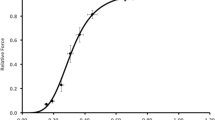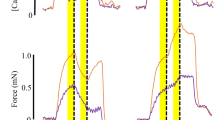Summary
Single skeletal muscle fibres ofR. temporaria (0.9–2.5° C) were stimulated to produce a 1 s isometric tetanus at regular intervals until constant mechanical responses were attained. Various degrees of force depression (‘fatigue’) were produced by decreasing the contraction interval from 30 or 15 min (control) to 120, 60, 30 and 15 s, respectively. In this way the steady-state tetanic force could be reversibly reduced to approximately 70% of the control value. The velocity of shortening at zero load,V 0, was determined at each level of fatigue using an approach for direct measurement ofV 0.
V 0 was not significantly affected as long as the decrease in force was less than 10%. With further reduction of the isometric tension there was a progressive decline ofV 0 according to the following empirical relationship between percentage depression of force (ΔP 0) and maximum speed (ΔV 0) of shortening: ΔV 0=0.006 ΔP 2.480 −1.0 (correlation coefficient, 0.86). Cine photographic recording of nylon markers on the fibre surface provided evidence that fatigue developed uniformly along the fibre with no sign of failure of excitation in any segment.
The change in mechanical performance during fatigue could be reproduced in the non-fatigued fibre by reducing the pH of the external medium within the range 8.0–6.6 using a bicarbonate-CO2 buffer. A decrease in pH thus reduced both the rate of rise and the total amplitude of isometric force and prolonged the relaxation phase. Furthermore, there was a drop inV 0 that was related to the force decline in approximately the same way as observed during fatigue.
The results support the idea that fatigue involves both a reduced state of activation of the contractile system and a specific (activation independent) inhibition of crossbridge turnover. Increased intracellular H+ concentration is likely to contribute to the development of both these effects during fatigue.
Similar content being viewed by others
References
AICKIN, C. C. & THOMAS, R. C. (1977) Micro-electrode measurement of the intracellular pH and buffering power of mouse soleus muscle fibres.J. Physiol. 267, 791–810.
ASHLEY, C. C. & MOISESCU, D. G. (1977) Effect of changing the composition of the bathing solutions upon the isometric tension-pCa relationship in bundles of crustacean myofibrils.J. Physiol. 270, 627–52.
Ashley, C. C., Franciolini, F., Lea, T. J. & Lignon, J. (1979) Effect of carbon dioxide on calcium transient and tension responses from fibres of the barnacleBalanus nubilus. J. Physiol., Lond. 296, 71P.
BENDALL, J. R. (1969)Muscles, Molecules and Movement. London: Heinemann.
BLINKS, J. R., RÜDEL, R. & TAYLOR, S. R. (1978) Calcium transients in isolated amphibian skeletal muscle fibres: detection with aequorin.J. Physiol. 277, 291–323.
BRENNER, B. (1980) Effect of free sarcoplasmic Ca2+ concentration on maximum unloaded shortening velocity: measurements on single glycerinated rabbit psoas muscle fibres.J. Musc. Res. Cell Motil. 1, 409–28.
CLEWORTH, D. R. & EDMAN, K. A. P. (1972) Changes in sarcomere length during isometric tension development in frog skeletal muscle.J. Physiol. 227, 1–17.
DAWSON, M. J., GADIAN, D. G. & WILKIE, D. R. (1978) Muscular fatigue investigated by phosphorus nuclear magnetic resonance.Nature 274, 861–6.
DAWSON, M. J., GADIAN, D. G. & WILKIE, D. R. (1980) Mechanical relaxation rate and metabolism studied in fatiguing muscle by phosphorus nuclear magnetic resonance.J. Physiol. 299, 465–84.
Eberstein, A. & Sandow, A. (1963) Fatigue mechanisms in muscle fibres. InThe Effect of Use and Disuse on Neuromuscular Functions (edited by Gutman, E. and Hnik, P.), pp. 515–526. Nakladatelstvi Ceskoslovenské akademie ved Praha.
EDMAN, K. A. P. (1975) Mechanical deactivation induced by active shortening in isolated muscle fibres of the frog.J. Physiol. 246, 255–75.
EDMAN, K. A. P. (1979) The velocity of unloaded shortening and its relation to sarcomere length and isometric force in vertebrate muscle fibres.J. Physiol. 291, 143–59.
EDWARDS, R. H. T., HILL, D. K. & JONES, D. A. (1975) Metabolic changes associated with the slowing of relaxation in fatigued mouse muscle.J. Physiol. 251, 287–301.
FABIATO, A. & FABIATO, F. (1978) Effects of pH on the myofilaments and the sarcoplasmic reticulum of skinned cells from cardiac and skeletal muscles.J. Physiol. 276, 233–55.
FITTS, R. H. & HOLLOSZY, J. O. (1978) Effects of fatigue and recovery on contractile properties of frog muscle.J. appl. Physiol. 45, 899–902.
GONZALEZ, N. C., GERBRANDT, M. & BROWN, E. B. (1976) Changes in skeletal muscle cell pH during graded changes in PCO 2.Respir. Physiol. 26, 207–12.
GONZALEZ-SERRATOS, H., SOMLYO, A. V., McCLELLAN, G., SHUMAN, H., BORRERO, L. M. & SOMLYO, A. P. (1978) Composition of vacuoles and sarcoplasmic reticulum in fatigued muscle: Electron probe analysis.Proc. natn. Acad. Sci. 75, 1329–33.
GRABOWSKI, W., LOBSIGER, E. A. & LÜTTGAU, H. C. (1972) The effect of repetitive stimulation at low frequencies upon the electrical and mechanical activity of single muscle fibers.Pflügers Arch. ges. Physiol. 334, 222–39.
HEISLER, N. (1975) Intracellular pH of isolated rat diaphragm muscle with metabolic and respiratory changes of extracellular pH.Respir. Physiol. 23, 243–55.
HUXLEY, A. F. (1957) Muscle structure and theories of contraction.Prog. Biophys. biophys. Chem. 7, 255–318.
IZUTSU, K. T. (1972) Intracellular pH, H ion flux and H ion permeability coefficient in bullfrog toe muscle.J. Physiol. 221, 15–27.
JULIAN, F. J. (1971) The effect of calcium on the force-velocity relation of briefly glycerinated frog muscle fibres.J. Physiol. 218, 117–45.
JULIAN, F. J. & MOSS, R. L. (1981) Effects of calcium and ionic strength on shortening velocity and tension development in frog skinned muscle fibres.J. Physiol. 311, 179–99.
MATTIAZZI, A. R. & EDMAN, K. A. P. (1979) Efecto de la acidosis hipercápnica sobre la tension tetanica y la velocidad de acortamiento en fibras esqueléticas aisladas.Medicina 39, 767 (abstract).
NANNINGA, L. B. (1962) On the inhibition of myosin ATP-ase by ADP.Archs Biochem. Biophys. 96, 51.
NASSAR-GENTINA, V., PASSONNEAU, J. V., VERGARA, J. L. & RAPOPORT, S. J. (1978) Metabolic correlates of fatigue and of recovery from fatigue in single frog muscle fibers.J. gen. Physiol. 72, 593–606.
PODOLSKY, R. J. & TEICHHOLZ, L. E. (1970) The relation between calcium and contraction kinetics in skinned muscle fibres.J. Physiol. 211, 19–35.
PORTZEHL, H., ZAORALEK, P. & GAUDIN, J. (1969) The activation by Ca2+ of the ATPase of extracted muscle fibrils with variation of ionic strength, pH and concentration of Mg ATP.Biochim. Biophys. Acta 189, 440–8.
POOLE-WILSON, P. A. & CAMERON, I. R. (1975) Intracellular pH and K+ of cardiac and skeletal muscle in acidosis and alkalosis.Am. J. Physiol. 229, 1305–10.
PRINGLE, J. W. S. (1967) The contractile mechanism of insect fibrillar muscle.Progr. Biophys. 17, 3–60.
SCHÄDLER, M. (1967) Proportionale Aktivierung von ATPase-aktivität und Kontraktions-spannung durch Calciumionen in isolierten contraktilen Strukturen verschiedener Muskelarten.Pflügers Arch. ges. Physiol. 296, 70–90.
SPANDE, J. J. & SCHOTTELIUS, B. A. (1970) Chemical basis of fatigue in isolated mouse soleus muscle.Am. J. Physiol. 219, 1490–5.
THAMES, M. D., TEICHHOLZ, L. E. & PODOLSKY, R. J. (1974) Ionic strength and the contraction kinetics of skinned muscle fibres.J. gen. Physiol. 63, 509–30.
TRENTHAM, D. R., ECCLESTON, J. F. & BAGSHAW, C. R. (1976) Kinetic analysis of ATPase mechanisms.Q. Rev. Biophys. 9, 217–81.
Author information
Authors and Affiliations
Rights and permissions
About this article
Cite this article
Edman, K.A.P., Mattiazzi, A.R. Effects of fatigue and altered pH on isometric force and velocity of shortening at zero load in frog muscle fibres. J Muscle Res Cell Motil 2, 321–334 (1981). https://doi.org/10.1007/BF00713270
Received:
Issue Date:
DOI: https://doi.org/10.1007/BF00713270




